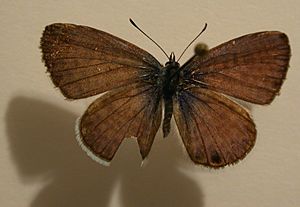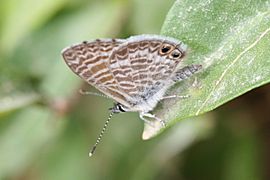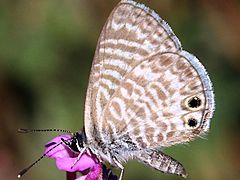Marine blue facts for kids
Quick facts for kids Marine blue |
|
|---|---|
 |
|
 |
|
| Scientific classification | |
| Genus: |
Leptotes
|
| Species: |
marina
|
| Synonyms | |
|
|
The marine blue butterfly (scientific name: Leptotes marina) is a beautiful, small butterfly. It's also known as the striped blue. This butterfly belongs to a group called the Lycaenidae family, which includes many small, colorful butterflies. You can find the marine blue butterfly flying around in North America and Central America.
What Does It Look Like?
The marine blue butterfly is quite small. Its wingspan (how wide it is when its wings are open) is usually between 22 and 29 millimeters. That's about the size of a large coin!
You can spot these adult butterflies flying from April to September in the northern parts of their habitat. But if you're in the warmer southern regions, you might see them all year long!
-
The underside of a marine blue butterfly in Montebello, California.
Life Cycle and What They Eat
Like all butterflies, the marine blue starts its life as a tiny egg. This egg hatches into a larva, also known as a caterpillar. These caterpillars love to munch on different plants!
They eat leaves from plants like Astragalus, Amorpha californica, Acacia greggii, Dalea purpurea, Dolichos lablab, Galactia, Glycyrrhiza lepidota, Prosopis glandulosa, Lysiloma thornberi, Lathyrus odoratus, Medicago sativa, Lotus scoparius dendroides, Phaseolus, Wisteria sinensis, and Plumbago.
Sometimes, these caterpillars are found near Argentine ants (Iridomyrmex humilis). These ants are not native to the areas where the butterflies live, but they sometimes interact with the caterpillars.
See also




